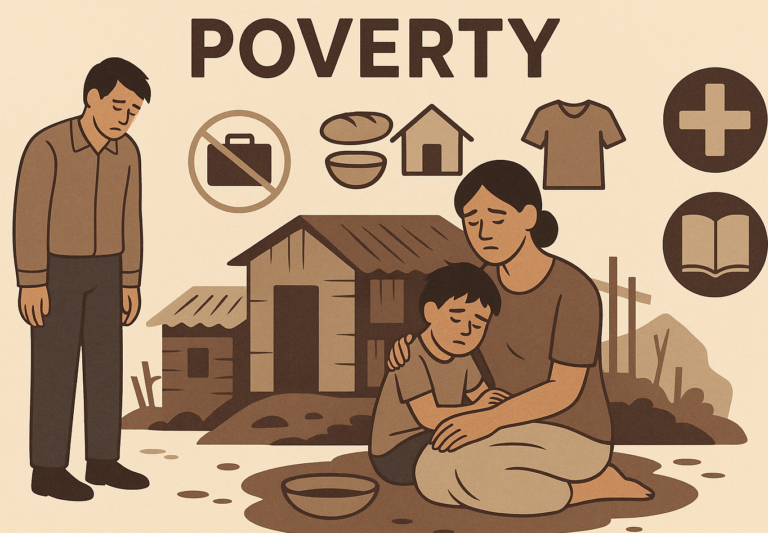Understanding Gross Domestic Product (GDP)
Gross Domestic Product (GDP) is a term you often hear in economics, the news, or when discussing how well a country is doing economically. GDP is the total value of all goods and services produced within a country over a specific period (usually a year or a quarter). It’s like adding up everything that’s made or done in a country to see how much it’s worth.

Why is GDP Important?
GDP is a key indicator used to measure the health of a country’s economy. When a country’s GDP is growing, it usually means the economy is doing well, businesses are producing more, people are working, and incomes are rising. On the other hand, if GDP is shrinking, it may indicate that the economy is in trouble, and people might be losing jobs or businesses may be slowing down.
How is GDP Measured?
There are three main ways to measure GDP, each focusing on different aspects of the economy:
1. Production Approach (Output Approach)
This method looks at the total output (production) of goods and services. It adds up the value of everything produced in the economy, whether it’s food, cars, services like teaching or healthcare, or things like technology and entertainment.
- Example: If a country produces 1 million cars in a year, the total value of those cars is counted towards GDP.
2. Income Approach
This method looks at the total income earned by people and businesses in the economy. It adds up all the wages, profits, rents, and taxes earned within the country.
- Example: If people earn salaries from their jobs, businesses make profits, and property owners receive rent, all of these earnings are included in the GDP.
3. Expenditure Approach (Spending Approach)
This is the most common approach to measuring GDP. It adds up all the money spent in the economy by individuals, businesses, and the government. It includes:
- Consumption (C): The money spent by households on goods and services like food, clothing, healthcare, and entertainment.
- Investment (I): The spending on business investments like new machinery, buildings, or construction.
- Government Spending (G): The money the government spends on goods and services, like schools, hospitals, or defense.
- Net Exports (NX): This is the difference between a country’s exports (goods sold to other countries) and imports (goods bought from other countries). If a country exports more than it imports, it has a trade surplus. If it imports more than it exports, it has a trade deficit.
The formula for GDP using the Expenditure Approach is:
Where:
- C = Consumption
- I = Investment
- G = Government spending
- X = Exports
- M = Imports
Example:
- If people in the country spend $1 trillion on goods and services, businesses invest $500 billion in new equipment, the government spends $600 billion on infrastructure, and the country exports $200 billion worth of goods while importing $150 billion, the GDP would be:
Types of GDP
There are two common types of GDP used to analyze the economy:
1. Nominal GDP
Nominal GDP is the value of all goods and services produced in a country in current prices, without adjusting for inflation. This means that if prices increase over time, nominal GDP will appear higher, even if the actual production hasn’t increased.
- Example: If a country produces the same number of cars as last year but the price of each car has increased, nominal GDP will be higher even though actual output hasn’t changed.
2. Real GDP
Real GDP adjusts for inflation, which gives a more accurate picture of an economy’s actual growth. By removing the effects of rising prices, real GDP reflects the actual increase or decrease in the production of goods and services.
- Example: If the number of cars produced is the same as last year, but prices have increased due to inflation, real GDP would show no growth, while nominal GDP might show an increase.
GDP Per Capita
GDP per capita is another important measure. It divides the total GDP of a country by its population. This gives a rough estimate of the average income or standard of living of people in the country.
- Formula:
- Example: If a country has a GDP of $2 trillion and a population of 100 million, the GDP per capita would be $20,000. This means that, on average, each person in the country is responsible for producing $20,000 worth of goods and services.
Limitations of GDP
While GDP is a very useful tool for measuring economic performance, it has some limitations:
- Doesn’t Measure Inequality: GDP doesn’t tell you how wealth is distributed among the population. A high GDP might hide the fact that most wealth is concentrated in the hands of a few people.
- Doesn’t Measure Non-Market Activities: GDP doesn’t count activities that are not bought and sold in the market. For example, if someone stays home to take care of their family, it’s not counted in GDP, even though it adds value to society.
- Environmental Impact: GDP doesn’t take into account environmental degradation. A country’s GDP can rise due to the exploitation of natural resources, but this doesn’t measure the harm done to the environment.
- Quality of Life: GDP doesn’t account for the well-being of people. It focuses on economic output but doesn’t measure things like health, education, and overall happiness.
Conclusion
In summary, GDP is the total value of all goods and services produced in a country, and it’s used as a key indicator to measure the economic health of that country. It’s calculated through different methods, but the expenditure approach is the most common. While GDP is helpful, it’s important to remember that it doesn’t capture everything about a country’s prosperity, like income inequality or the environment.











